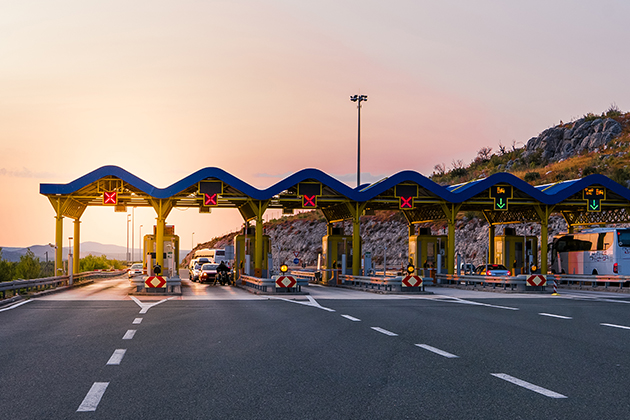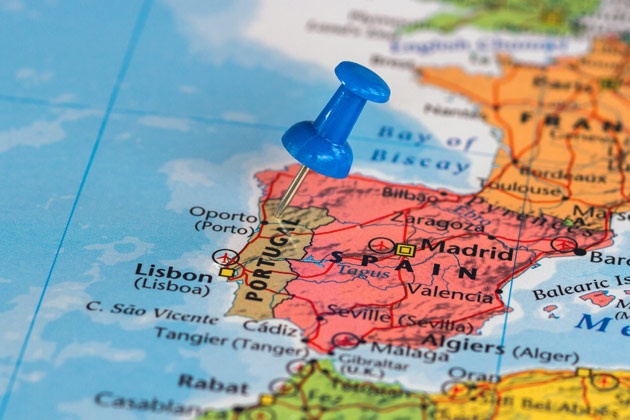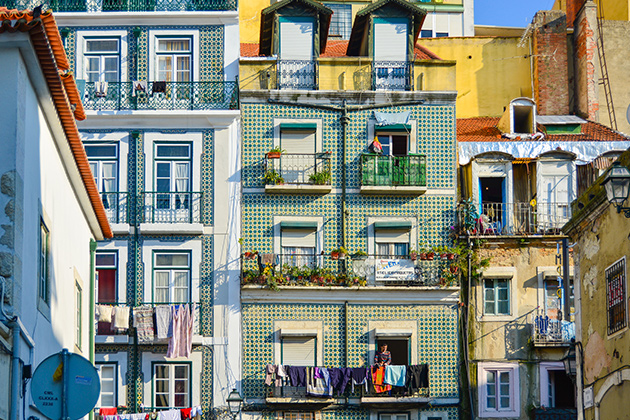
Portugal is just the right size for traveling by car. Served by a fair network of highways, in which you can drive faster, more safely and with less traffic, you can get from North to South quite quickly.
At the beginning or at the end of the highways you’ll often find a toll which, in Portugal, can be traditional (with a toll booth) or fully electronic (with overhead detectors). They each use different types of payment methods, but there are some methods which can be used for both.
The methods can vary depending on whether your car has a Portuguese or foreign license plate. Let us explain.
If your vehicle has a Portuguese license plate
Traditional toll
Toll worker
One of the options when you go through a traditional toll in Portugal is to pay the toll worker who is in one of the booths. In some cases you can also use an automatic machine on the outside of the booth.
Some highways only have one control point, which could be at the beginning or at the end of the route, depending on which way you are going. In other cases, you might need to withdraw a ticket at the start of your journey and hand it into the worker (or insert it in the machine) at the booth at the end. In these cases, the amount you pay depends on the type of vehicle you are driving and the distance.
Via Verde
Via Verde is a method of electronic payment which allows you to drive through the toll without stopping. The system uses a device you place on the front windshield of your car. When you go through the toll in the Via Verde lane it reads the device and deducts the correct amount directly from your bank account. Motorcycles get a 30% reduction on tolls in Portugal when they use Via Verde. The Via Verde lanes are identified with a white V in a green square. Here you can find the price range of this service (in Portuguese).
Pre-paid Via Verde
This method is similar to the conventional Via Verde, the difference being that the amount due is not deducted from your account. The user can charge the device beforehand, and the respective amounts are deducted as it is used. You will be sent a warning as your balance begins to get low. You can charge the device at any Post Office or CTT shop, PayShop agent or Multibanco ATM machine. You can consult the prices here (in Portuguese).
Fully electronic toll
Post-paid
When you go through a fully electronic toll in Portugal, which is usually composed of an overhead detector with no toll booth, payment has to be made within five days. You can pay at CTT Shops and Post Offices (or you can use the CTT website or CTT app to obtain ATM references), PayShop agents, at the Information desk of the Francisco Sá Carneiro Airport, or using the Multibanco ATM system. Indicate the license plate of the car to find out how much you need to pay. If you prefer to pay at an ATM just insert the information here to obtain your reference.
Via Verde and pre-paid Via Verde
Via Verde and pre-paid Via Verde also work with fully electronic tolls, just as with conventional ones.
Anonymous pre-paid
The anonymous pre-paid system is similar to the pre-paid Via Verde. However, instead of associating the license plate to the device, it can be used for different vehicles, as long as they are of the same class. It can be obtained at CTT Shops and it can be charged at any CTT Shop or Post Office, PayShop agent, or Multibanco ATM machine.
If your car has a foreign license plate
Traditional toll
Toll worker
If you choose to pay the toll worker directly, then the system is exactly the same as if your car had a Portuguese license plate. You can pay the worker in the booth or use cash or card in the automatic machine on the outside of the booth.
Via Verde Visitors
Via Verde Visitors is a system that allows cars with foreign license plates to drive through tolls without stopping in Portugal. The device is placed on the windshield of the car and when the car goes through the Via Verde lane the amount due is deducted directly from the bank account associated with it. You can check out prices and conditions here (in Portuguese).
The device is valid for 90 days and costs €6 for the first week, and €1,5 for each week after that. You also pay a deposit of €15, to be refunded upon the return of the device.
Fully electronic tolls
This system allows you to pay fully electronic tolls in Portugal by associating your bank card to the license plate of the car. To be able to use the system, however, you need to register at one of the following points, located near border crossings:
- A28 – Viana do Castelo service station;
- A24 – 3,5 km from the Chaves/Verin border;
- A25 – Alto de Leomil (Vilar Formoso) service station;
- A22 – By the Castro Marim/Ayamonte border.
When you find the terminal all you need is to insert your card and the license plate is automatically associated with it. It costs €0,74 to register. For every trip, you pay a €0,32 administrative cost, besides the actual amount of the toll. So if the toll is one euro, you pay €1,32. The service lasts 30 days.
Toll Service has two options. One is to purchase a pre-paid card, which will be associated to the license plate of your car. Each time you go through a toll the amount is withdrawn from your bank account. It lasts three days.
The other option is to buy a card which allows you to travel pre-defined routes (return). These are:
- Porto Airport (via the A28/A41 or the A41/A42);
- Faro airport (via the A22, which is commonly known as the Via do Infante).
The Toll Card is a pre-paid card (€5, €10, €20 or €40) which is associated to the license plate. The amount is deducted from your bank account each time you go through a toll. It lasts one year and each trip has an administrative cost of €0,32.
The Via Verde Visitors service can also be used on fully electronic tolls.
Pre-paid with a temporary Via Verde device
Like the Toll Card, this method doesn’t use a card, but a device you place on the car’s windshield. The balance is valid for 90 days, counting from when it was charged.
Vehicle classes
Finally, and regardless of the nationality of the license plate, it is important to bear in mind that there are four classes of vehicles. Class 1 is the cheapest, and 4 is the most expensive. A Renault Clio, a Peugeot 208, or a motorcycle, for instance, pay the lowest class, but a Renault Kadjar or a Peugeot 4007 will pay class 2.
However, when using a Via Verde device, some class 2 vehicles pay the same as class 1. Here you can see which class your vehicle belongs to (without Via Verde) and here you can calculate the amount it will pay (both links in Portuguese only).



